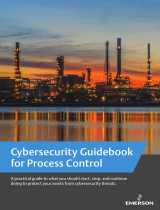
Table of Contents
1. About IEC-G102-BP Series ................................................................................................................ 1-1
Introduction ....................................................................................................................................... 1-2
Main Functions ................................................................................................................................... 1-3
2. Getting Started ................................................................................................................................. 2-1
Getting Started Task List ..................................................................................................................... 2-2
Opening the Management Console ........................................................................................................ 2-3
Changing the Administrator’s Password ................................................................................................. 2-4
3. The System Screen ............................................................................................................................ 3-1
System Information ............................................................................................................................ 3-2
System Status .................................................................................................................................... 3-2
Resource Monitor ................................................................................................................................ 3-2
4. The Visibility Screen .......................................................................................................................... 4-1
Viewing Asset Information ................................................................................................................... 4-2
Viewing Real-time Network Application Traffic ........................................................................................ 4-3
5. The Device Screen ............................................................................................................................. 5-1
Configuring Network Settings ............................................................................................................... 5-2
Configuring Interface Link Mode for Ports .............................................................................................. 5-2
6. The Object Profiles Screens............................................................................................................... 6-1
Configuring IP Object Profile ................................................................................................................ 6-2
Configuring Service Object Profile ......................................................................................................... 6-3
Configuring Protocol Filter Profile .......................................................................................................... 6-4
Specifying Commands Allowed in an ICS Protocol ............................................................................ 6-4
Advanced Settings for Modbus Protocol .......................................................................................... 6-5
7. The Security Screens ......................................................................................................................... 7-1
Security General Settings .................................................................................................................... 7-2
Configuring Security Operation Mode .................................................................................................... 7-3
Cybersecurity ..................................................................................................................................... 7-3
Configuring Cybersecurity - Intrusion Prevention Setting .................................................................. 7-3
Configuring Cybersecurity – Denial of Service Prevention ................................................................. 7-4
Policy Enforcement ............................................................................................................................. 7-5
Configuring Policy Enforcement ..................................................................................................... 7-5
Adding Policy Enforcement Rules ................................................................................................... 7-6
Managing Policy Enforcement Rules ............................................................................................... 7-7
8. The Pattern Screens .......................................................................................................................... 8-1
Viewing Device Pattern Information ...................................................................................................... 8-2
Manually Updating the Pattern .............................................................................................................. 8-2
9. The Log Screens ................................................................................................................................ 9-1
Viewing Cybersecurity Logs .................................................................................................................. 9-2
Viewing Policy Enforcement Logs .......................................................................................................... 9-3
Viewing Protocol Filter Logs.................................................................................................................. 9-3
Viewing Asset Detection Logs ............................................................................................................... 9-4
Viewing System Logs .......................................................................................................................... 9-4
Viewing Audit Logs.............................................................................................................................. 9-4
10. The Administration Screens ............................................................................................................ 10-1
Account Management ........................................................................................................................ 10-2
Built-in User Accounts ................................................................................................................ 10-3
Adding a User Account ............................................................................................................... 10-3
Changing Your Password ............................................................................................................ 10-3
Configuring Password Policy Settings .................................................................................................. 10-4
System Management ......................................................................................................................... 10-4
Configuring Device Name and Device Location Information ............................................................. 10-5
Configuring Control List Access from Management Clients .............................................................. 10-5
Configuring Management Protocols and Ports ................................................................................ 10-6
The Sync Setting Screen (Pro Version) ................................................................................................ 10-6
Enabling Management by SDC .................................................................................................... 10-6
The Syslog Screen ............................................................................................................................ 10-7
Configuring Syslog Settings ........................................................................................................ 10-7
Syslog Severity Levels ............................................................................................................... 10-8
Syslog Severity Level Mapping Table ........................................................................................... 10-8
The System Time Screen ................................................................................................................... 10-9
Configuring System Time ........................................................................................................... 10-9
The Back Up/Restore Screen ............................................................................................................ 10-10
Backing Up a Configuration ....................................................................................................... 10-10
Restoring a Configuration ......................................................................................................... 10-10






















